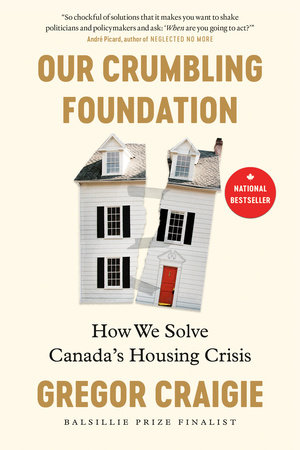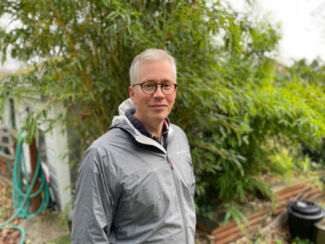Breaking ground on housing policy
Our Crumbling Foundation: How We Solve Canada’s Housing Crisis
by Gregor Craigie
Toronto: Random House Canada, 2024
$25.00 / 9781039009387
Reviewed by Matthew Downey
*

If there is a single issue that consistently permeates Canadian politics for most people, it is the housing crisis. Gregor Craigie’s Our Crumbling Foundation is an apropos study of Canada’s housing crisis situated in a global context. Craigie is an excellent authority for the endeavour of determining British Columbia’s position in such a worldwide issue, having amassed experience working both for CBC Radio in Victoria and the BBC World Service in London. Ultimately, as a journalist, Craigie does not propose any quick answers, but rather acts to raise awareness of the immense problem at the very heart of Canadian society. Most people are aware of the housing crisis, but not many would likely care to coherently and cooperatively identify the way to address it. Craigie warns that action must be taken soon, for the situation has grown to such a degree that to remedy it will take a long while. Utilising examples from various international settings, Craigie shows that the way begin addressing the housing crisis in Canada is by changing the way we think about housing.
The problem at the heart of the housing crisis is deceptively basic: that of supply. The details of solving that issue are complex. This is especially the case in a federal system like Canada’s in which the municipal, provincial, and federal governments must coordinate to effectively implement a solution. Aptly, Craigie begins his book with a look at Vancouver, which is described as being like the opposite of the Eagles’ song Hotel California: “You can come, but you can’t stay.” One might expand that line to You can be born and raised here, but you can’t stay, as Craigie’s first chapter details the search of a local Vancouver couple who, even after saving money by staying with their parents for years, are forced to move to Calgary in order to be able to afford a house of their own. Premier David Eby, Craigie notes, has focused a large amount of rhetoric on the need for more housing supply; however, there is an important distinction as to the type of new housing supplied. Craigie relays the criticism of housing advocates who say that there is a sufficient amount of housing construction going on – the problem is that what most developers are building is unaffordable. Developers like to build luxury apartments that ensure the maximum financial return on their investment.
Using the example of Victoria, in which the effectiveness of zoning reform is weakened by municipal politics, Craigie shows how problems with profit-minded developers can be exacerbated by government. Developers see no benefit to entering into an overregulated market in a municipal culture that seems strongly against attracting population density. The disruption caused by municipal politics is due to a lack of coordination between municipalities (of which there are 13 in Greater Victoria’s Capital Regional District, governing a population of just c.400,000) as well as jurisdiction’s close proximity to its voters, many of whom find high-density housing to be a potential scourge on their area. Victoria’s situation aptly puts on the tripartite display of frustration from the federal, provincial, and municipal governments. A lack of federal funding, provincial overregulation in construction, and municipal zoning work together to sap the city of its ability to facilitate population growth. According to Craigie, some experts think that the hostile and convoluted environment for housing development in Victoria will lead to it becoming a resort town, accessible only to people who are both wealthy and unlikely to need access to public transit.

Key to the change that Craigie hopes to inspire is people stopping to think about housing as something that is primarily an investment. He does not denigrate those who rent out housing as a rule, but rather shows the exploitative path that some people take when motivated to squeeze the most amount of profit out of a piece of property – namely, short term rentals such as those featured on Airbnb. While often a harmless way for a homeowner to capitalize on a spare room, Craigie describes how it can also be an industry subject to rogue investors who might make vast sums of money off residential properties, often pushing out long-term tenants. With attempts to regulate the short-term rental industry, a major setback has been enforcement. This fits in with a major theme in Craigie’s message – merely talking about an issue, or passing legislation, is meaningless without communication and coordination in addressing a solution.
A common theme throughout Our Crumbling Foundation is the housing-first approach to addressing wider social issues. While many might carry the assumption that people living on the street suffering with addiction and other mental health issues might owe their living conditions to their lifestyle and headspace, Craigie highlights important cases of people who believe otherwise. One such case is that of a man in Helsinki, Finland, addicted to drugs and homeless, only finding respite from the arctic temperatures in heated public toilets. This man’s story is used by Craigie to illustrate the primacy of the issue of housing in relation to other social ills. For people without a stable sense of home, there is little to no secure foundation on which to build or recover their lives. This lack of a sense of security can even extend to those who either rent or own their home if rising expenses become rapidly untenable.
Part of finding a new way to think about housing is discovering innovative forms of construction. If supply is the primary issue at hand, then it goes without saying that more quick and efficient modes of building houses should be explored. Craigie describes how Ireland, which has a major housing crisis of its own despite a relatively small population, utilised pre-fabricated housing in rapidly providing housing to Ukrainian refugees. In Mexico, 3D printed housing using technology from an American innovator provides simple yet stable shelter, allowing families to escape environments plagued by flooding. These examples serve as proof that large strides might be taken in the direction of progress when inspiration meets a pressing challenge.
Craigie shows that Canadians much change the way they think about housing. When the difference is between someone having a stable source of shelter and living on the street with no security, distinctions of style and square footage are far less important than accessibility and affordability. Craigie uses numerous examples of strategies people have used worldwide to make housing accessible and affordable to people of various walks of life. This includes formal modes of public and housing, like the French creating space for middle-income families in flats crowning the historic La Samaritaine department store, or government-provided housing for key workers such as teachers, or the dense and publicly built and subsidized flats leased out by the government in Singapore. However, changing perspectives must meet people in Canada from where they are. Craigie details how from coast to coast – in both Duncan on Vancouver Island and the Annapolis Basin off the Bay of Fundy – Canadians are resorting to informal and mobile forms of housing. In the chapter on Duncan, Craigie shows how even people forced to live out of camper vans due to inaccessible housing options are finding it difficult due to municipal bylaws outlawing overnight parking and profit-seeking RV lot owners. To live out of a vehicle may not be the ideal, but for some it is the only option; Craigie describes the potentially detrimental impacts of misdirected political energies – stemming from traditional views of housing – to already desperate people.
Our Crumbling Foundation is gripping in the way it puts on full display the failures of Canada’s housing accessibility on a global stage. Around the world, people are finding it difficult to find housing; however, Craigie’s comparative take, utilising an international set of illustrative anecdotes, shows that most countries are much farther along the road of addressing housing issues than is Canada. This does not serve to chastise the country of Canada for its inadequate response. Rather, it is an important warning, asserting that action must be taken and inspiring that action through various examples of possible strategies as developed in other states. What is required in Canada is an inspired, cooperative, and authoritative approach that takes the federal structure of the country into account by addressing its pluralistic character. Many different strategies to create housing have been tried in many different contexts worldwide; Craigie shows how the problem in Canada is not due to any particular geographic or demographic issues, but rather a lack of coordinated will and leadership. The depth and breadth of Craigie’s analysis is impressive, giving a sense of direction to a realm of policy that often seems bleak in its partisanship and illusory political rhetoric. Craigie is greatly successful in instilling a sense of action in addressing an issue that too many young people might face with reserved anxiety.
*

Matthew Vernon Downey is an independent writer and researcher based out of Victoria, British Columbia. He has degrees from UVic (BA hons) and the London School of Economics (MSc) [Editor’s note: Matthew Downey has also reviewed books by Robert Crossland, Donna (Yoshitake) Wuest with Joe W. Gardner, Mike Whalen, D.C. Reid, Alexander Globe, and Angus Scully for BCR.]
*
The British Columbia Review
Interim Editors, 2023-25: Trevor Marc Hughes (non-fiction), Brett Josef Grubisic (fiction and poetry)
Publisher: Richard Mackie
Formerly The Ormsby Review, The British Columbia Review is an online book review and journal service for BC writers and readers. The Advisory Board now consists of Jean Barman, Wade Davis, Robin Fisher, Barry Gough, Hugh Johnston, Kathy Mezei, Patricia Roy, Maria Tippett, and Graeme Wynn. Provincial Government Patron (since September 2018): Creative BC. Honorary Patron: Yosef Wosk. Scholarly Patron: SFU Graduate Liberal Studies. The British Columbia Review was founded in 2016 by Richard Mackie and Alan Twigg.
“Only connect.” – E.M. Forster
3 comments on “Breaking ground on housing policy”
Things have been changing rapidly since Craigie send his book off for publication. The Province of B.C. is currently building more housing than ever before, but the Premier is aware that “a continuous effort to build more homes faster is needed”. What is important to cut “red tape” is the co-operation of cities and the municipalities. The city of Victoria is making a concerted effort in this. All political parties are on side with developing more housing, but some have problems with Craigie’s main point that houses should not be seen as a tool for vast profits.
The Seymour Street project is a good example, where at least 30% of units to be rented will be below market value. This affordability is, of course, possible through cost savings provided by the City of Vancouver, as well as federal and provincial financing. Since the book has appeared the government has provided 2 billion in low-coast financing for expedited builds.
We need to realize the time it takes to put policies in place to speed up housing. The independent Sightline Institute gives the B.C. government first place in Pro-housing policy. They note: “In just one month in 2023, the province legalized fourplexes, allowed apartment buildings up to 20 stories near all transit stations, eliminated public hearings for plan-compliant buildings, ended parking requirements in transit-oriented districts.”
To see what has been produced as of June 10 of this year see:
https://www.bchousing.org/projects-partners/Building-BC/homes-for-BC